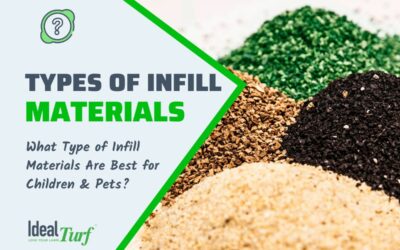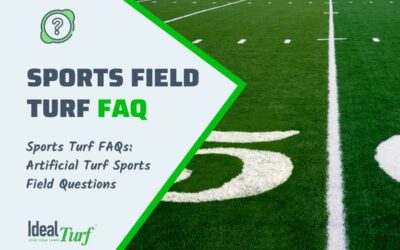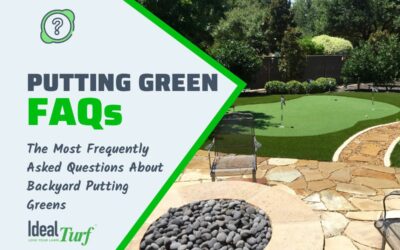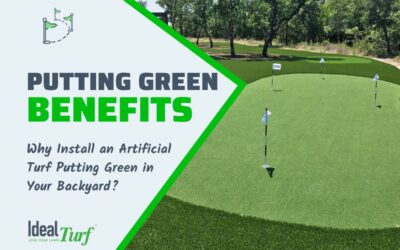Debunking The 10 Most Common Artificial Grass Myths & Misconceptions

There are a great number of artificial grass myths and misconceptions floating around.
Most of them stem from outdated and/or incomplete information.
You might have encountered a few of these common ones:
- Is artificial grass really made of old tires?
- Fake grass is way too expensive
- Synthetic grass is maintenance-free
This article sets the record straight and debunks many of the myths you may have heard about artificial grass.
Let’s dive in to separate the facts from the fiction.

MYTH #1: Artificial Grass is Not Safe for Dogs & Pets
This myth couldn’t be further from the truth.
One of the most common residential artificial turf applications is in dog runs and designated dog potty areas.
Providing a safe, clean, low-maintenance environment is one of the most frequently cited reasons homeowners choose to install pet-friendly artificial grass.
Dogs and natural grass don’t mix.
Your canine companion will destroy your grass lawn by digging, creating ruts, and leaving brown dog urine spots.
Your lawn is none too kind to your pup either, as it hosts nasty insects, ticks, and other parasites that can be harmful to your pooch.
Fertilizers, herbicides and insecticides that keep your lawn green and pest-free can be toxic to dogs and other outdoor pets as well.
You can skirt all these problems by installing fake grass for dogs in a dog run or to replace your natural grass lawn.
This will provide your pup with a dog-friendly backyard to run and play.

MYTH #2: Artificial Grass is Not Safe for Children
This myth is likely rooted in the crumb rubber infill (made from shredded tires) that’s used on sports fields.
While the jury is still out on the effects of crumb rubber on children, it’s no longer a commonly used infill option.
Most commercial and residential infills are made of silica sand, cork, walnut shells, or quartz — all of which are natural substances and non-toxic for children and pets, making modern artificial grass completely safe for children to play on.
This is evident in the growing popularity of fake grass as a play area ground cover, which is an increasingly common commercial artificial turf application.
It even made its way onto our list of 12 backyard ideas for kids.
There are numerous benefits to installing artificial grass on playgrounds or in children’s play areas:
- Eliminates muddy spots
- Less risk of falling from uneven spots
- Cushion can be added beneath turf
- No grass stains on clothing
- Fewer insects
- Reduced bacteria when the grass is equipped with the Microbe-Safe™ antimicrobial backing

MYTH #3: Fake Grass Gets Too Hot During The Summer
It is true that fake grass does get hot in the summer because it doesn’t have water flowing through and cooling it like natural grass.
That said, there are ways to keep your artificial grass from becoming too hot during the summer months.
To keep your fake grass cool, you can:
- Install lighter colors of synthetic grass to lower the heat
- Add a lighter-colored infill
- Use an evaporative cooling infill like T°Cool® infill
- Install artificial grass in shady areas
On days that are particularly sweltering, you can cool off your synthetic lawn with a quick spritz from the garden hose so your pets or kids can enjoy the outdoors.

MYTH #4: Synthetic Grass is Too Expensive
As far as upfront costs go, artificial grass is more expensive than installing sod or reseeding your lawn initially.
However, purchasing synthetic grass will save you money over time in maintenance, equipment, and water costs.
You’ll also save dozens of hours each year that you would otherwise have spent mowing, watering, and caring for a natural grass lawn.
Artificial grass should be viewed as a long-term investment as it will pay for itself over time with the savings you’ll see in the long run.

MYTH #5: Artificial Lawns Have Poor Drainage
This myth is just plain false.
When installed properly, artificial turf drains more reliably and efficiently than natural grass.
Artificial grass lawns are installed over a sub-base of compacted decomposed granite, sand, and river rocks to provide a solid, yet porous foundation.
This results in better and faster drainage than you’d experience with natural grass, which only drains as fast as the dirt underneath it can handle.
It’s important to note that different artificial grass products are designed for varying volumes of drainage.
If you live in an area or climate that is prone to flooding, be sure to select a turf product with DUAL FLOW backing to minimize the risk of pooling water.
If you live in a relatively dry area, you can likely get away with hole-punched backing, which still drains well, but not as fast as DUAL FLOW.

MYTH #6: Artificial Grass Lowers Property Value
This may have been true in the past when your only choice for fake grass was AstroTurf.
However, modern artificial lawns are extremely close in look and feel to the real thing.
In light of growing water concerns, artificial grass can qualify a home as “green,” which is a major selling point.
More and more Texas homeowners are installing artificial grass for lower maintenance and water bills, as well as its lush, green, natural-looking appearance all year long.
Any property feature that meets those parameters (and is eco-friendly to boot) adds to a home’s value rather than detracts from it.

MYTH #7: Synthetic Grass Requires NO Maintenance
This one is almost true.
Compared to all the hours you spend mowing, weeding, edging, and fertilizing a natural grass lawn, the maintenance of an artificial lawn will seem like nothing at all.
But the maintenance for fake grass isn’t zero.
There are a few things you’ll need to do to keep your fake grass lawn looking green and pristine:
- Remove debris. This isn’t any different from your natural grass lawn. If twigs, leaves, or doggy-doo show up on your artificial grass, you’ll need to remove them. Failing to do so gives places for bacteria, moss, mildew, or weeds to grow.
- Rake. While the infill and thatch of fake grass will help the fibers stand up, areas with high traffic will need a little fluff with a rake or power brush every so often to prevent matting.
- Rinse. This one is critical if you have pets that “go” on your artificial lawn. Rinse the areas your pets use to potty a few times per week to minimize the build-up of odors and bacteria.
- Refill. The infill (small beads of silica sand or other materials) that are laid over your artificial turf isn’t stuck there, so some of it will inevitably wander off over time. You’ll need to replenish your infill about once per year to keep the artificial grass fibers plush and prevent the grass from harmful UV damage by the sun.

MYTH #8: Artificial Grass Fades Over Time
High-quality turf products incorporate UV inhibitors into the fiber/yarn resin.
These substances prevent your artificial grass from fading.
The most reputable turf installers will also offer a warranty — Ideal Turf’s covers 15-20 years — against fading.

MYTH #9: Artificial Grass Looks Fake
There was a time when this myth was true.
However, artificial grass has improved significantly in recent years.
Manufacturing techniques and technologies now make it difficult to tell the difference when comparing fake grass vs. real grass.
The latest generation of artificial grass products mimic a natural grass appearance with variations in grass blades, density, and colors.
Artificial grass products can be matched to blend in with natural landscaped areas around your home.
Also, quality manufacturers develop their products’ grass blades with non-abrasive textures that are soft like real grass.

MYTH #10: Artificial Grass is Bad for the Environment
Artificial turf is actually a great, environmentally-friendly landscape solution.
For starters, it doesn’t require toxic pesticides, herbicides, or fertilizers.
These can poison children and pets, as well as fish and ecosystems as they run off your lawn and into the watershed.
Second, artificial grass requires no gas-powered lawn care equipment.
The EPA reports that a push mower emits as much pollution in one hour as 11 cars, and a riding mower emits as much as 34 cars.
That makes the carbon footprint of maintaining a fake grass lawn much lower than that of a natural grass one.
Finally, artificial grass significantly reduces water usage and water bills, which is one reason why it is so popular among homeowners and businesses — particularly in drought-prone areas with imposed water restrictions.
The EPA estimates that an average of 9 billion gallons of water are used on residential lawns daily in America — that’s an average of 27 gallons of water per person, per day.
All of these advantages make artificial grass a viable, eco-friendly alternative to a natural grass lawn.

Final Thoughts on Artificial Grass Myths & Misconceptions
There are a lot of specifics to understand about artificial grass, and the first step to creating a flawless, maintenance-free lawn is to educate yourself on the many features and options available.
Learn about:
We have artificial turf products for every situation, free quotes, and world-class customer support.
Let’s get an expert on your side to help you put together the perfect installation plan.
We have teams of the best artificial grass installers located throughout Texas and in Oklahoma.
At Ideal Turf, we truly believe artificial grass is worth the money, and we are happy to help you explore this decision by answering any of your questions before buying turf.
Get your FREE artificial grass installation estimate by clicking the “GET A QUOTE” button or feel free to give us a call at 800-204-4650.
Author: Tim Taylor
Recent Posts
- How Does Artificial Turf Help With Allergies Compared to Natural Grass?
- Artificial Turf Innovations & Advancements: The Future of Synthetic Grass
- The Top 10 Best Artificial Turf Backyard Putting Green Installers in & Around Lubbock, TX
- Types of Infill Materials Used on Artificial Turf: Which Infills Are Best for Children & Pets?
- The Top 10 Best Artificial Turf Backyard Putting Green Installers in & Around Oklahoma City, OK






